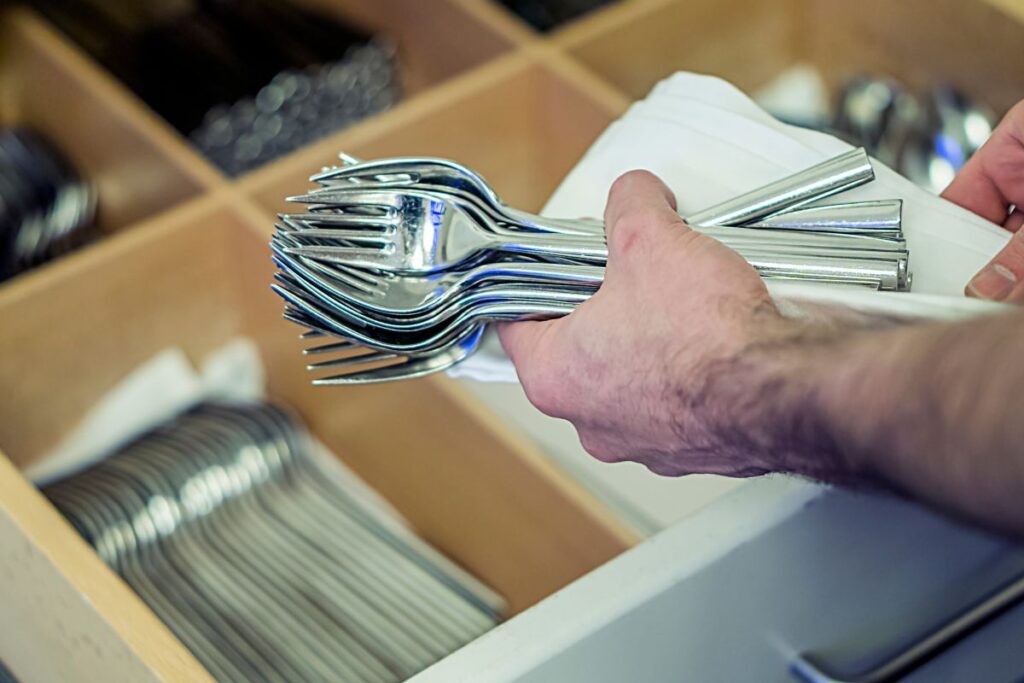Silverware and cutlery are one of the most prized possessions in a household. Not only are items like sterling silver pieces expensive, but they also hold sentimental value as they may have been around for generations. For these reasons, it is necessary to be careful.
You may have a silverware and cutlery collection that you’ve been meaning to pack up and move for a while now. Perhaps you’re finally getting around to it, or maybe you’re moving houses and need to pack everything up. Either way, packing silverware and cutlery can be a bit tricky.
Each kitchen is different, and so is every cook’s way of packing their silverware and cutlery for a move. Some people like to sort everything by type. In contrast, others prefer to keep their everyday items separate from their more delicate pieces. No matter your system, you can follow a few general tips to ensure your silverware and cutlery arrive at your new home in one piece.
The Steps You’ll Need to Pack Your Silverware
Kitchen utensils, cooking utensils, or valuable silverware are no different. They can get damaged or misplaced easily if not packed correctly. They can cause damage to other items in your shipment, like scratches, or even injure movers if not precisely cushioned. The secret to successfully packing silverware for a move is to be as systematic and orderly as possible. That process begins with packing your cutlery correctly.

Materials you’ll need to pack silverware
How do you know how to pack silverware correctly? First is to know and have the packing materials needed on hand:
- Packing paper or newsprint
- Packing Tape
- Paper towels or clean rags
- Small and medium-sized boxes (dish pack boxes work great)
- Styrofoam peanuts or bubble wrap
- Unprinted tissue paper
- Sturdy box
- A permanent marker
You will also need a system to keep track of your silverware. This could be as simple as Ziploc bags or plastic wrap, or you could get more creative and use small boxes or Tupperware containers.
Clean your counter or table and prepare the box for silverware
Once you have gathered all your materials, the next step is to clear a space on your counter or table. You will need a flat surface to sort and organize your silverware. If you have a dishwasher, this is a great time to run it and get all of your silverware clean and ready to go. As you organize them, please place them in the box designated for silverware.
Make sure your silverware is dry and clean
Before packing your silverware, make sure that it is completely dry. Any moisture can cause tarnishing or rusting, especially if your silverware has been in storage for a while.
You want to make sure that your silverware is clean. Any food particles or residue can attract pests and cause damage. If you have time, you can hand-wash your silverware with warm soapy water. If not, run it through the dishwasher on a short cycle.
Use clean towels or rags to dry your silverware as you take it out of the dishwasher. This will help prevent water spots. You can also polish your silverware before packing it up. This will help protect it during the move and make unpacking a bit easier. Once your silverware is clean and dry, you can start packing it.
Organize all pieces by category
The next step is to organize your silverware into different categories. This will make it easier to find what you need when you unpack. You can organize by type of silverware, such as forks, knives, and spoons. Or you can organize by use, such as everyday and formal silverware.
You can also use Ziploc bags or plastic wrap to organize your silverware. Just label each bag or container, so you know what is inside. Once everything is organized, you can start packing it up.
Fill the open spaces with crushed paper
Open spaces in your boxes can cause damage to your silverware. To prevent this, fill the empty spaces with crumpled packing paper or styrofoam peanuts to cushion your silverware and keep it from moving around in the box. This will help keep your silverware safe and secure during the move.
You can also use unprinted tissue paper or clean rags to wrap your silverware before packing it up. This protects it from scratches and nicks. Again, label each bag or container to know what is inside.
Cover the tray with silverware
If you are using a tray or box, cover the bottom with packing paper or newsprint. You can also use unprinted tissue paper or clean rags. This provides a solid layer of protection and cushioning.
Once the bottom is covered, start placing your silverware in the tray. You can organize it however you like, but ensure each piece is wrapped individually. Once everything is covered up, please put it in its proper moving box or container and seal it with packing tape.
Organize the moving box by placing the wrapped silverware tray inside
If you are using a moving box, place the tray with the silverware inside. Put any necessary cushioning material around it, such as packing paper or newsprint. You can also use unprinted tissue paper or clean rags. Once everything is packed up, close the box and seal it with packing tape or rope.
Don’t forget to put your contact information on the box so the movers will know who to call if there are any problems.
You can also put “fragile” and “handle with care” stickers on the box to ensure your silverware is adequately protected during the move.
Wrap larger pieces separately
If you have larger pieces of silverware, such as serving utensils or platters, you will want to wrap them separately. Use packing paper or newsprint to wrap each piece individually. You can also use unprinted tissue paper or clean rags. If you are using packing paper, make sure to put a layer between each piece of silverware to prevent scratching and breaking.
You can add other kitchen items, such as wrapped measuring cups and utensils. Once everything is wrapped, you can start packing it up.
You can use a moving box or tray for your larger pieces of silverware. Make sure to cover the bottom and edges with packing paper or newsprint. You can also use special cloth bags or clean rags for consistent protection.
Once the bottom is covered, start placing your silverware in the box or tray. Organize it and make sure that each piece is wrapped tightly. Once everything is packed up, repeat the process of sealing and labeling.
Packing Cutlery when Moving
Cutlery, such as knives, can be some of the most delicate items in your kitchen. And as we know, packing knives can be dangerous regardless of their size. That is why you need to be cautious when packing knives for moving. Here is a walkthrough on the safest way to pack cutlery when moving.
Gather the Correct Packing Materials and Supplies
Packing your silverware is similar to packing your cutlery. You will want to use the same materials, such as:
- Crushed Packing paper or newsprint
- Unprinted tissue paper or clean rags
- Boxes or trays
- Crumpled packing paper or styrofoam peanuts
- Ziploc bags or plastic wrap
- Packing tape or rope
- Cutlery tray
- Small moving box
You will also want to ensure that you have a sharpie or pen to label your boxes. This will make unpacking much more manageable.
If you have any fragile or high-value items, you may want to pack them separately. You can use a smaller box or Ziploc bag for these items.
Sort Knives by Type and Size
Start by sorting your knives by type and size. You will want to put all the steak knives together, all the butter knives, etc. This will make packing them much more straightforward. Putting them in separate containers will also help to prevent any accidents. You don’t want your knives getting mixed up and causing any injuries.
Wrap and roll each knife individually
You will want to wrap each knife individually in packing paper or newsprint. You can also use unprinted tissue paper or clean rags. If you are using packing paper, make sure to put a layer between each knife to prevent scratching and breaking. Once they are all wrapped, you can start packing them up.
Use bubble wrap and packing tape when moving
You can use bubble wrap and packing tape to secure your knives when moving. Just wrap each knife carefully and put them in their respective containers. Make sure you don’t put too many knives in each bag, as the added layers of protection will not be effective.
Store your knives in a cutlery block
If you have a cutlery block, you can store your knives there. Make sure to put packing paper or newsprint at the bottom of the block. You can also use unprinted tissue paper or clean rags for a robust foundation.
Once the bottom is covered, start placing your knives in the block organized. Make sure that each knife is wrapped tightly. Once everything is packed up, repeat the process of sealing and labeling.
Use a Moving Box to Transport Knives
Once all the cutlery is packed up, you can use a moving box to transport them. Label the box clearly with “Fragile: Knives” or something similar. This will let the movers know that the package needs to be handled carefully.
You can also put the box in your car while driving to your new home. Ensure it is securely packed so the knives don’t move around during transport.
With each box, cover the edges to provide enough support to last them through the moving process without destroying themselves and other items. Then you’re good to go!
Keep Moving With Our Help!
At The Long Distance Moving Company of Sarasota Co., we know that packing up for a move can be frustrating. Still, with some planning and care, you can do it without any problems. Let us know if you need help, and we would be happy to pack and move them for you. We have the experience and training to get the job done right. Now that you know what to do, you’re ready to pack like a pro! Request a quote today!











